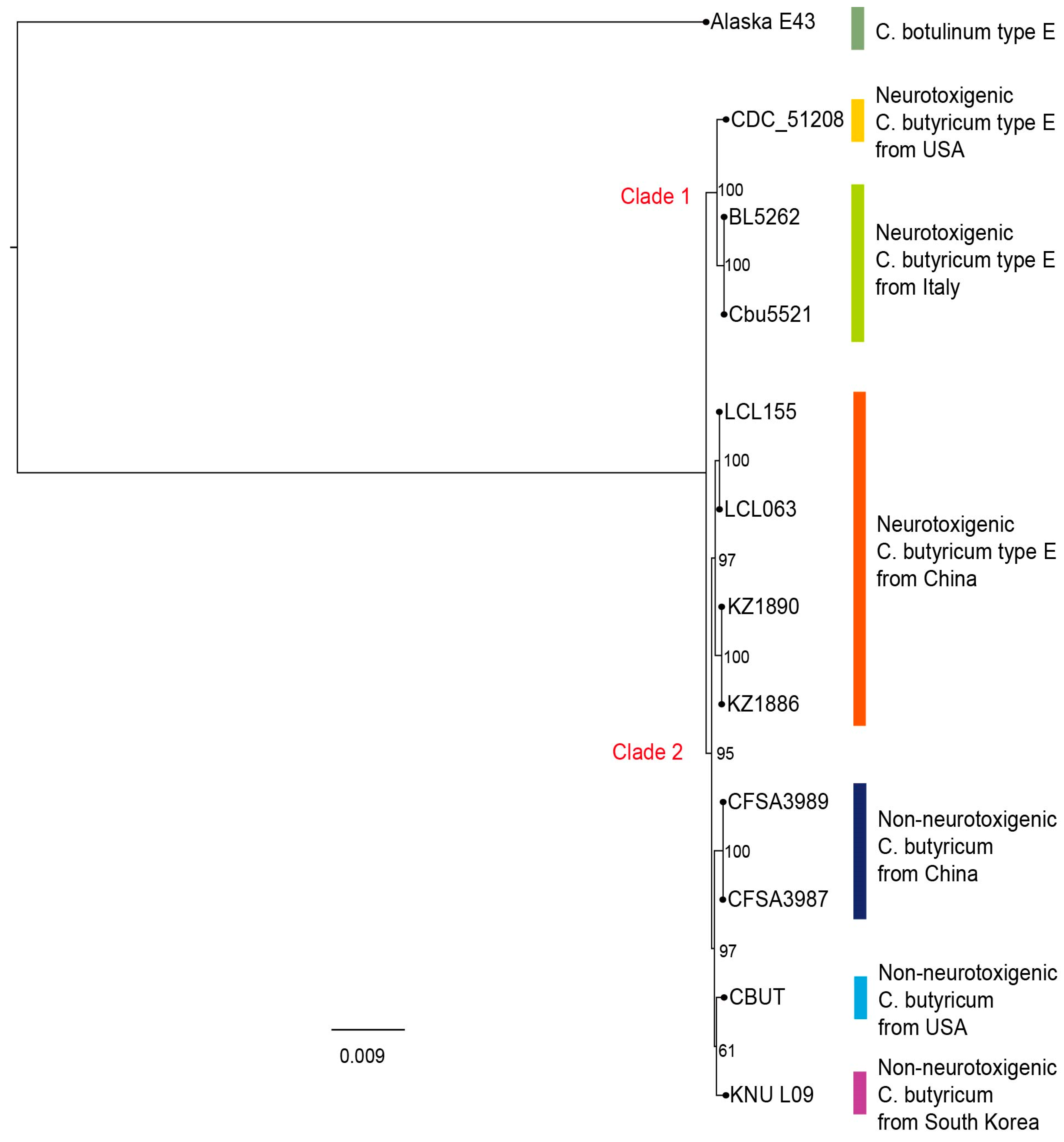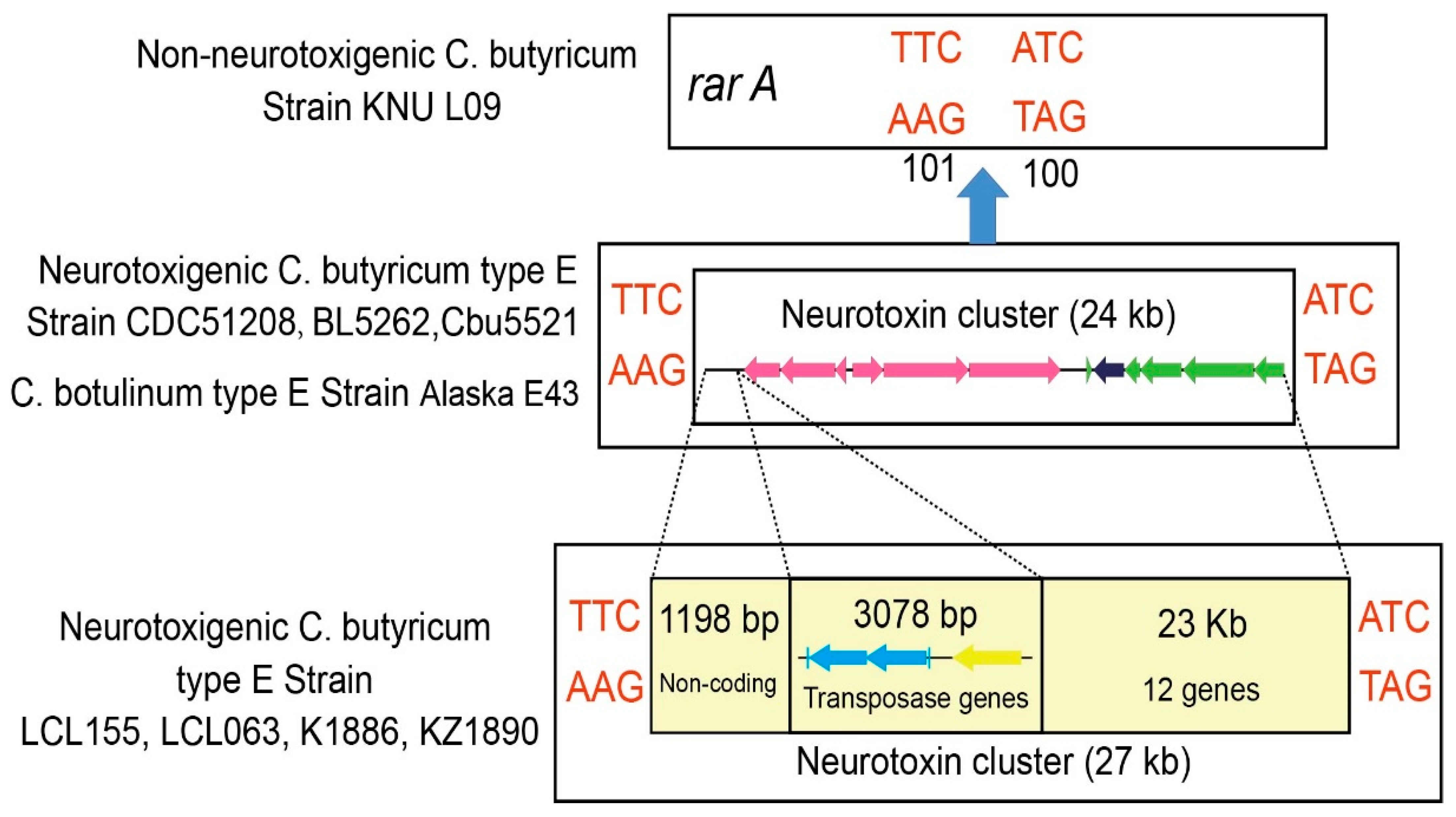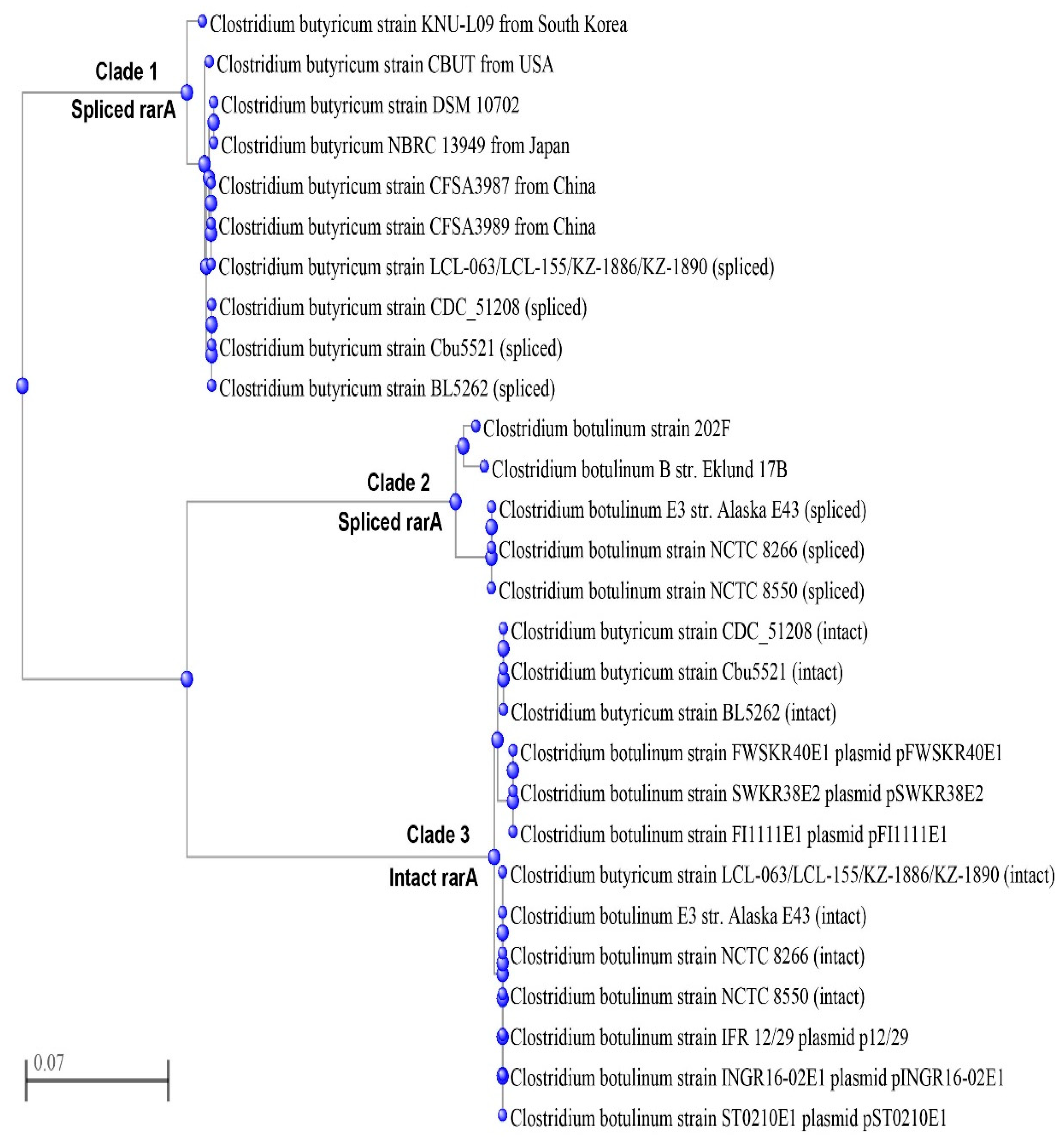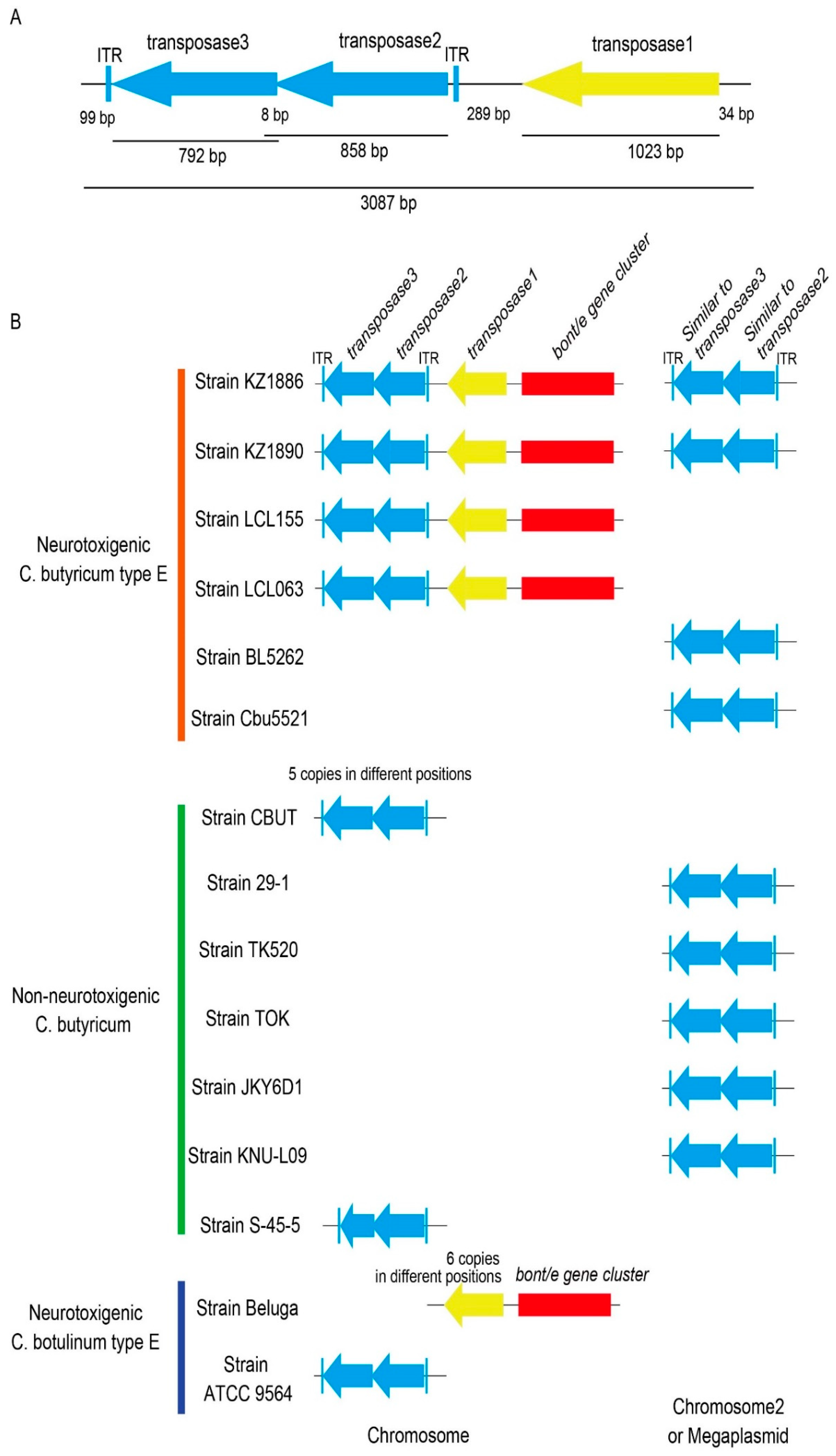Novel Putative Transposable Element Associated with the Subtype E5 Botulinum Toxin Gene Cluster of Neurotoxigenic Clostridium butyricum Type E Strains from China
Abstract
:1. Introduction
2. Results
2.1. C. butyricum Type E Strains and General Genome Features
2.2. Comparative Genomic Analysis
2.3. Comparative Analyses of the Bont/e Gene Clusters and Adjacent Regions
2.3.1. Bont/e Genes
2.3.2. RarA Genes
2.3.3. Transposase Genes
3. Discussion
4. Materials and Methods
4.1. Bacterial Strains
4.2. DNA Extraction
4.3. Genome Sequencing, Assembly and Annotation
4.4. Comparative Genomics
4.5. Comparative Analyses of the Bont/e Gene Clusters and Adjacent Regions
4.6. Data Deposition
Supplementary Materials
Author Contributions
Funding
Institutional Review Board Statement
Informed Consent Statement
Data Availability Statement
Conflicts of Interest
References
- Rossetto, O.; Pirazzini, M.; Fabris, F.; Montecucco, C. botulinum neurotoxins: Mechanism of action. Handb. Exp. Pharmacol. 2021, 263, 35–47. [Google Scholar]
- Hatheway, C.L. Toxigenic clostridia. Clin. Microbiol. Rev. 1990, 3, 66–98. [Google Scholar] [CrossRef]
- Johnson, E.A. Clostridium botulinum. In Food Microbiology: Fundamentals and Frontiers, 5th ed.; Doyle, M.P., Diez-Gonzalez, F., Hill, C., Eds.; ASM Press: Washington, DC, USA, 2019; pp. 487–512. [Google Scholar]
- Aureli, P.; Fenicia, L.; Pasolini, B.; Gianfranceschi, M.; McCroskey, L.M.; Hatheway, C.L. Two cases of type E infant botulism caused by neurotoxigenic Clostridium butyricum in Italy. J. Infect. Dis. 1986, 154, 207–211. [Google Scholar] [CrossRef] [PubMed]
- Fenicia, L.; Franciosa, G.; Pourshaban, M.; Aureli, P. Intestinal toxaemia botulism in two young people, caused by Clostridium butyricum type E. Clin. Infect. Dis. 1999, 29, 1381–1387. [Google Scholar] [CrossRef] [Green Version]
- Fenicia, L.; Da Dalt, L.; Anniballi, F.; Franciosa, G.; Zanconato, S.; Aureli, P. A case of infant botulism due to Clostridium butyricum type E associated with Clostridium difficile colitis. Eur. J. Clin. Microbiol. Infect. Dis. 2002, 21, 736–738. [Google Scholar] [PubMed]
- Anniballi, F.; Fenicia, L.; Franciosa, G.; Aureli, P. Influence of pH and temperature on the growth and toxin production by neurotoxigenic strains of Clostridium butyricum type E. J. Food Prot. 2002, 65, 1267–1270. [Google Scholar] [CrossRef] [PubMed]
- Fu, S.W.; Wang, C.H. An overview of type E botulism in China. Biomed. Environ. Sci. 2008, 21, 353–356. [Google Scholar] [CrossRef]
- Meng, X.; Karasawa, T.; Zou, K.; Kuang, X.; Wang, X.; Lu, C.; Wang, C.; Yamakawa, K.; Nakamura, S. Characterization of a neurotoxigenic Clostridium butyricum strain isolated from the food implicated in an outbreak of food-borne type E botulism. J. Clin. Microbiol. 1997, 35, 2160–2162. [Google Scholar] [CrossRef] [Green Version]
- Meng, X.; Yamakawa, K.; Zou, K.; Wang, X.; Kuang, X.; Lu, C.; Wang, C.; Karasawa, T.; Nakamura, S. Isolation and characterisation of neurotoxigenic Clostridium butyricum from soil in China. J. Med. Microbiol. 1999, 48, 133–137. [Google Scholar] [CrossRef]
- Shelley, E.B.; O’Rourke, D.; Grant, K.; McArdle, E.; Capra, L.; Clarke, A.; McNamara, E.; Cunney, R.; McKeown, P.; Amar, C.F.; et al. Infant botulism due to C. butyricum type E toxin: A novel environmental association with pet terrapins. Epidemiol. Infect. 2015, 143, 461–469. [Google Scholar] [CrossRef]
- Wang, X.; Maegawa, T.; Karasawa, T.; Kozaki, S.; Tsukamoto, K.; Gyobu, Y.; Yamakawa, K.; Oguma, K.; Sakaguchi, Y.; Nakamura, S. Genetic analysis of type E botulinum toxin-producing Clostridium butyricum strains. Appl. Environ. Microbiol. 2000, 66, 4992–4997. [Google Scholar] [CrossRef] [Green Version]
- Franciosa, G.; Scalfaro, C.; Di Bonito, P.; Vitale, M.; Aureli, P. Identification of novel linear megaplasmids carrying a ß-lactamase gene in neurotoxigenic Clostridium butyricum type E strains. PLoS ONE 2011, 6, e21706. [Google Scholar] [CrossRef] [PubMed]
- Kalb, S.R.; Smith, T.J.; Moura, H.; Hill, K.; Lou, J.; Geren, I.N.; Garcia-Rodriguez, C.; Marks, J.D.; Smith, L.A.; Pirkle, J.L.; et al. The use of Endopep-MS to detect multiple subtypes of botulinum neurotoxins A, B, E, and F. Int. J. Mass Spectrom. 2008, 278, 101–108. [Google Scholar] [CrossRef]
- Macdonald, T.E.; Helma, C.H.; Shou, Y.; Valdez, Y.E.; Ticknor, L.O.; Foley, B.T.; Davis, S.W.; Hannett, G.E.; Kelly-Cirino, C.D.; Barash, J.R.; et al. Analysis of Clostridium botulinum serotype E strains by using multilocus sequence typing, amplified fragment length polymorphism, variable-number tandem-repeat analysis, and botulinum neurotoxin gene sequencing. Appl. Environ. Microbiol. 2011, 77, 8625–8634. [Google Scholar] [CrossRef] [Green Version]
- Peck, M.W.; Smith, T.J.; Anniballi, F.; Austin, J.W.; Bano, L.; Bradshaw, M.; Cuervo, P.; Cheng, L.W.; Derman, Y.; Dorner, B.G.; et al. Historical perspectives and guidelines for botulinum neurotoxin subtype nomenclature. Toxins 2017, 9, 38. [Google Scholar] [CrossRef] [PubMed]
- Hill, K.K.; Xie, G.; Foley, B.T.; Smith, T.J.; Munk, A.C.; Bruce, D.; Smith, L.A.; Brettin, T.S.; Detter, J.C. Recombination and insertion events involving the botulinum neurotoxin complex genes in Clostridium botulinum types A, B, E and F and Clostridium butyricum type E strains. BMC Biol. 2009, 7, 66. [Google Scholar] [CrossRef]
- Hassan, K.A.; Elbourne, L.D.; Tetu, S.G.; Johnson, E.A.; Paulsen, I.T. Genome sequence of the neurotoxigenic Clostridium butyricum Strain 5521. Genome Announc. 2014, 2, e00632-14. [Google Scholar] [CrossRef] [Green Version]
- Halpin, J.L.; Hill, K.; Johnson, S.L.; Bruce, D.C.; Shirey, T.B.; Dykes, J.K.; Lúquez, C. Finished whole-genome sequences of Clostridium butyricum toxin subtype E4 and Clostridium baratii toxin subtype F7 strains. Genome Announc. 2017, 5, e01050-17. [Google Scholar] [CrossRef] [Green Version]
- Carter, A.T.; Austin, J.W.; Weedmark, K.A.; Peck, M.W. Evolution of chromosomal Clostridium botulinum type E neurotoxin gene clusters: Evidence provided by their rare plasmid-borne counterparts. Genome Biol. Evol. 2016, 8, 540–555. [Google Scholar] [CrossRef] [PubMed]
- Schleifer, K.H. Phylum XIII. Firmicutes Gibbons and Murray 1978, 5 (Firmacutes [sic] Gibbons and Murray 1978, 5). In Bergey’s Manual of Systematic Bacteriology; De Vos, P., Garrity, G.M., Jones, D., Krieg, N.R., Ludwig, W., Rainey, F.A., Schleifer, K.H., Whitman, W.B., Eds.; Springer: New York, NY, USA, 2009; pp. 19–1317. [Google Scholar]
- Kwok, J.S.; Ip, M.; Chan, T.F.; Lam, W.Y.; Tsui, S.K. Draft genome sequence of Clostridium butyricum strain NOR 33234, isolated from an elderly patient with diarrhea. Genome Announc. 2014, 2, e01356-14. [Google Scholar] [CrossRef] [PubMed] [Green Version]
- Cassir, N.; Benamar, S.; La Scola, B. Clostridium butyricum: From beneficial to a new emerging pathogen. Clin. Microbiol. Infect. 2016, 22, 37–45. [Google Scholar] [CrossRef] [PubMed] [Green Version]
- Desper, R.; Gascuel, O. Fast and accurate phylogeny reconstruction algorithms based on the minimum-evolution principle. J. Comput. Biol. 2002, 9, 687–705. [Google Scholar] [CrossRef]
- Chaudhry, R.; Dhawan, B.; Kumar, D.; Bhatia, R.; Gandhi, J.C.; Patel, R.K.; Purohit, B.C. Outbreak of suspected Clostridium butyricum botulism in India. Emerg. Infect. Dis. 1998, 4, 506–507. [Google Scholar] [CrossRef] [PubMed] [Green Version]
- Abe, Y.; Negasawa, T.; Monma, C.; Oka, A. Infantile botulism caused by Clostridium butyricum type E toxin. Pediatr. Neurol. 2008, 38, 55–57. [Google Scholar] [CrossRef] [PubMed]
- Dykes, J.K.; Lúquez, C.; Raphael, B.H.; McCroskey, L.M.; Maslanka, S.E. Laboratory investigation of the first case of Clostridium butyricum type E infant botulism in the United States. J. Clin. Microbiol. 2015, 53, 3363–3365. [Google Scholar] [CrossRef] [Green Version]
- Hill, K.K.; Smith, T.J. Genetic diversity within Clostridium botulinum serotypes, botulinum neurotoxin gene clusters and toxin subtypes. Curr. Top. Microbiol. Immunol. 2013, 364, 1–20. [Google Scholar] [PubMed]
- Nawrocki, E.M.; Bradshaw, M.; Johnson, E.A. Botulinum neurotoxin-encoding plasmids can be conjugatively transferred to diverse clostridial strains. Sci. Rep. 2018, 8, 3100. [Google Scholar] [CrossRef]
- Poulain, B.; Popoff, M.R. Why are botulinum neurotoxin-producing bacteria so diverse and botulinum neurotoxins so toxic? Toxins 2019, 11, 34. [Google Scholar] [CrossRef] [PubMed] [Green Version]
- Arnon, S.S.; Schechter, R.; Inglesby, T.V.; Henderson, D.A.; Bartlett, J.G.; Ascher, M.S.; Eitzen, E.; Fine, A.D.; Hauer, J.; Layton, M.; et al. Botulinum toxin as a biological weapon: Medical and public health management. JAMA 2001, 285, 1059–1070. [Google Scholar] [CrossRef]
- Frost, L.S.; Leplae, R.; Summers, A.O.; Toussaint, A. Mobile genetic elements: The agents of open source evolution. Nat. Rev. Microbiol. 2005, 3, 722–732. [Google Scholar] [CrossRef]
- Scalfaro, C.; Iacobino, A.; Grande, L.; Morabito, S.; Franciosa, G. Effects of megaplasmid loss on growth of neurotoxigenic Clostridium butyricum strains and botulinum neurotoxin type E expression. Front. Microbiol. 2016, 7, 217. [Google Scholar] [CrossRef] [Green Version]
- Smith, T.J.; Tian, R.; Imanian, B.; Williamson, C.H.D.; Johnson, S.L.; Daligault, H.E.; Schill, K.M. Integration of complete plasmids containing bont genes into chromosomes of Clostridium parabotulinum, Clostridium sporogenes, and Clostridium argentinense. Toxins 2021, 13, 473. [Google Scholar] [CrossRef]
- Benoit, R.M. Botulinum neurotoxin diversity from a gene-centered view. Toxins 2018, 10, 310. [Google Scholar] [CrossRef] [PubMed] [Green Version]
- Franciosa, G.; Ferreira, J.L.; Hatheway, C.L. Detection of type A, B, and E botulism neurotoxin genes in Clostridium botulinum and other Clostridium species by PCR: Evidence of unexpressed type B toxin genes in type A toxigenic organisms. J. Clin. Microbiol. 1994, 32, 1911–1917. [Google Scholar] [CrossRef] [PubMed] [Green Version]
- Seemann, T. Prokka: Rapid prokaryotic genome annotation. Bioinformatics 2014, 30, 2068–2069. [Google Scholar] [CrossRef]
- Gardner, S.N.; Slezak, T.; Hall, B.G. kSNP3.0: SNP detection and phylogenetic analysis of genomes without genome alignment or reference genome. Bioinformatics 2015, 31, 2877–2878. [Google Scholar] [CrossRef] [Green Version]
- Stamatakis, A. RAxML-VI-HPC: Maximum likelihood-based phylogenetic analyses with thousands of taxa and mixed models. Bioinformatics 2006, 22, 2688–2690. [Google Scholar] [CrossRef] [PubMed]






| Strain | Genome Size (bp) | G + C Content (%) | No. of Contigs | No. of Coding Sequences | No. of tRNA Genes |
|---|---|---|---|---|---|
| KZ 1886 | 4,633,810 | 28.58% | 152 | 4232 | 91 |
| KZ 1890 | 4,575,226 | 28.78% | 986 | 4179 | 86 |
| LCL-155 | 4,577,534 | 28.90% | 227 | 4043 | 91 |
| LCL-063 | 4,523,830 | 28.70% | 473 | 4091 | 86 |
Publisher’s Note: MDPI stays neutral with regard to jurisdictional claims in published maps and institutional affiliations. |
© 2022 by the authors. Licensee MDPI, Basel, Switzerland. This article is an open access article distributed under the terms and conditions of the Creative Commons Attribution (CC BY) license (https://creativecommons.org/licenses/by/4.0/).
Share and Cite
Li, T.; Ning, N.; Iacobino, A.; Zhang, L.; Wang, H.; Franciosa, G. Novel Putative Transposable Element Associated with the Subtype E5 Botulinum Toxin Gene Cluster of Neurotoxigenic Clostridium butyricum Type E Strains from China. Int. J. Mol. Sci. 2022, 23, 906. https://doi.org/10.3390/ijms23020906
Li T, Ning N, Iacobino A, Zhang L, Wang H, Franciosa G. Novel Putative Transposable Element Associated with the Subtype E5 Botulinum Toxin Gene Cluster of Neurotoxigenic Clostridium butyricum Type E Strains from China. International Journal of Molecular Sciences. 2022; 23(2):906. https://doi.org/10.3390/ijms23020906
Chicago/Turabian StyleLi, Tao, Nianzhi Ning, Angelo Iacobino, Liangyan Zhang, Hui Wang, and Giovanna Franciosa. 2022. "Novel Putative Transposable Element Associated with the Subtype E5 Botulinum Toxin Gene Cluster of Neurotoxigenic Clostridium butyricum Type E Strains from China" International Journal of Molecular Sciences 23, no. 2: 906. https://doi.org/10.3390/ijms23020906






